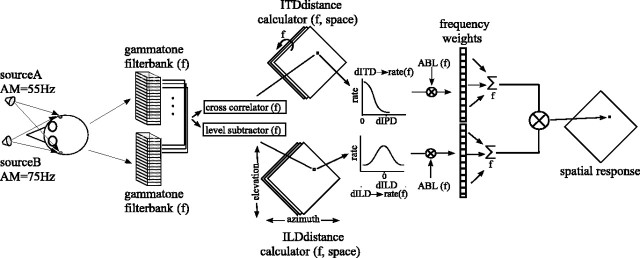Figure 2.
Model to estimate neuronal response to two sound sources. One snapshot in time is shown, and succeeding time epochs were assumed to be independent. Each stimulus was convolved with the left- and right-ear HRIRs corresponding to the stimulus locations in head-centered space. The signals for each ear were then added together and passed through paired gammatone filterbanks. The outputs of each filter pair were cross-correlated to give the ITD, and their levels were subtracted (right minus left, in decibels) to give the ILD for that frequency band. For a given cell, these location- and frequency-dependent cues were then converted into dILD and dITD values by subtracting the ILDopt and ITDopt of the cell, respectively, and used as indices into the rate-distance functions of the cell. These functions supplied frequency-specific estimates of the firing rate response of the cell to each cue, which were then multiplied by the frequency-specific ABL of the stimulus and the frequency weights of the cell. The responses were then summed across frequency and multiplied together (ITD response × ILD response) to give a final estimate of the firing of the cell. The process was then independently repeated for each location in space and each succeeding time epoch. AM, Amplitude modulation; f, frequency.

